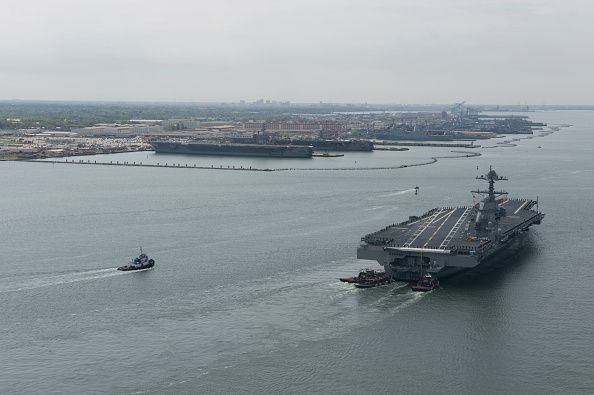USS Gerald Ford: All You Need To Know About US' Nuclear-Powered Aircraft Carrier

The commissioning of the U.S. Navy’s newest aircraft carrier — USS Gerald R. Ford is set to take place in a ceremony presided over by President Donald Trump later this week.
Designated CVN-78, it is the lead ship of the U.S. Navy’s supercarriers ( the unofficial descriptive term for the largest type of aircraft carrier —typically those that displace 64,000 metric tons).
Read: Facts About China’s First Aircraft Carrier Liaoning, Which Was Displayed To Public In Hong Kong
Costing about $12.9 billion, it has been built to replace the U.S. Navy's existing Nimitz-class carriers which are a class of ten nuclear-powered aircraft carriers. According to the U.S. Navy website, the CVN 78 is designed to operate effectively with almost 700 fewer crew members than the Nimitz class. It is the first aircraft carrier designed with all electric utilities, eliminating steam service lines from the ship, reducing maintenance requirements, and improving corrosion control. Technologies such as the Electromagnetic Aircraft Launch System (which launches carrier-based aircraft from an aircraft catapult using a linear motor drive instead of the conventional steam piston drive) have also been installed in the Ford.
The carrier will be capable of carrying up to 90 aircraft including the F-35 Joint Strike Fighter, EA-18G Growler electronic attack aircraft, MH-60R / S helicopters, unmanned air vehicles, and unmanned combat air vehicles, navaltechnology.com reported.
Some major design changes in the carrier include a larger flight deck to improve aircraft maneuverability, a repositioned "island" (the tower where the captain sits) for better visibility and improvements in weapons and material handling. These systems are expected to streamline flight operations and allow Ford to launch 33 percent more aircraft than older carriers in the fleet.
The construction of this carrier began in 2005 in what would be the most expensive warship the United States military has ever built. The ship was christened in 2013 and Ford's daughter, Susan Ford Bales, was named the ship's sponsor.
It was delivered in May 2017 “with a significant amount of outstanding construction, tests” and sea trials, the Government Accountability Office (GAO) said in a report that examined shortcomings in the Navy’s processes for ensuring quality and accepting finished ships. Even as it was delivered 32 months later than it was originally planned, it is estimated that the Navy will still have to spend almost $780 to finish deferred work, correct deficiencies and conduct Pentagon-mandated shock tests and another outfitting, according to Bloomberg.
“The ship is not also yet to complete its navigation certification and cyber security inspection, nor does it have all the certifications necessary to conduct aviation operations, among other things”, according to the GAO.
GAO also said: “The Navy has made liberal use of the various exceptions to its process for some of its most expensive and technologically sophisticated ships, including the Ford, that permit them to be delivered in a substantially incomplete state."
Read: US Fighter Jet Downs Iranian Drone In Syria, Second Pro-Regime Aircraft Shot Down In 3 Days
According to CNN, after Ford's commissioning July 22, it is set to undergo months of additional testing to examine and rectify any remaining deficiencies before its deployment, which is scheduled for 2020.
Two other ships have been announced in the class — CVN-79 named after John F. Kennedy which is under construction and CVN-80 or Enterprise which has been only planned as yet.
© Copyright IBTimes 2024. All rights reserved.





















